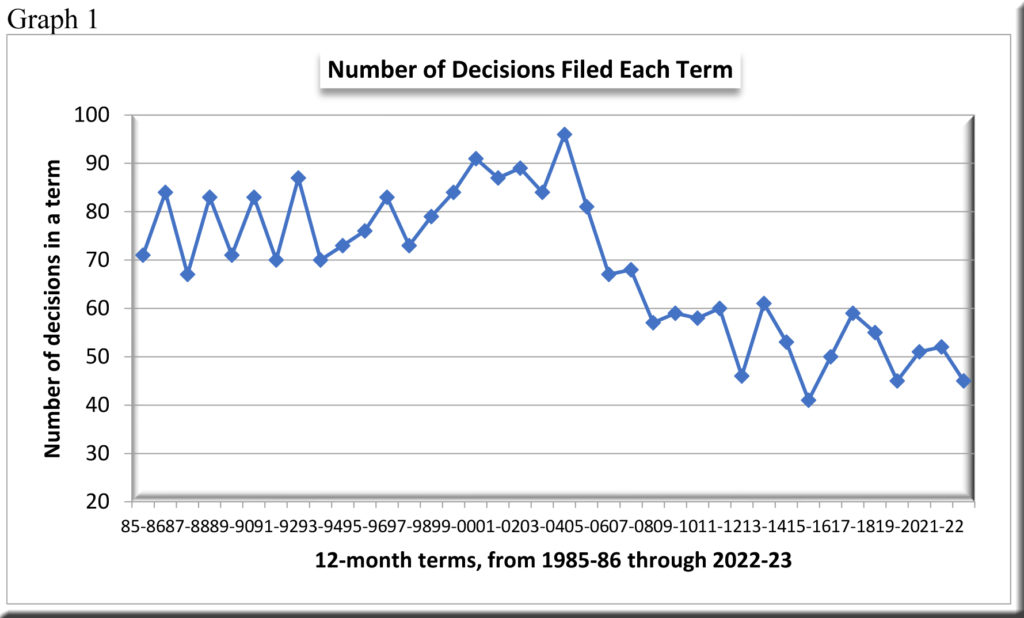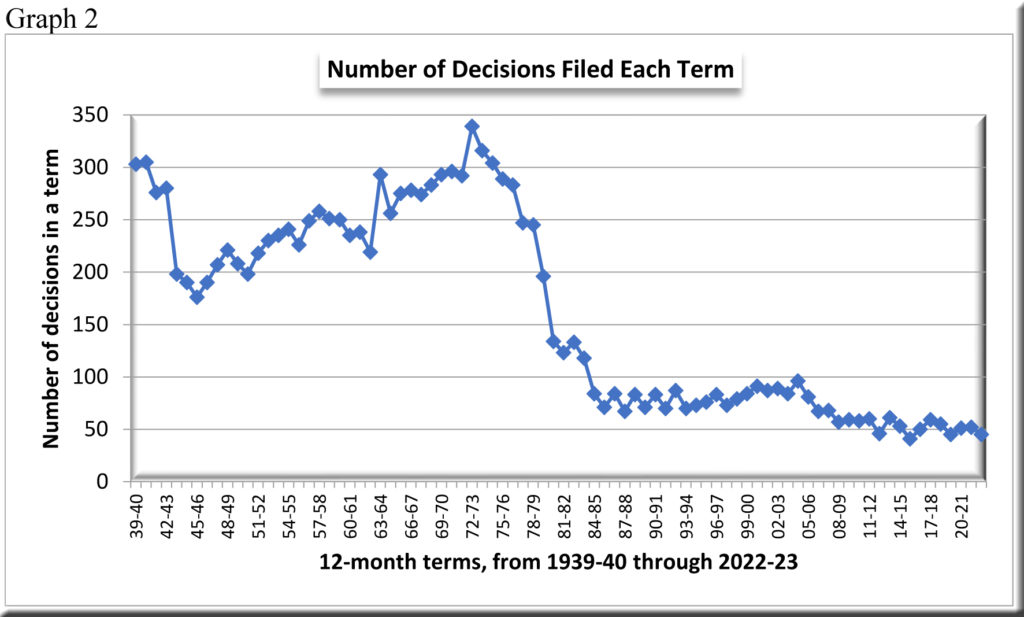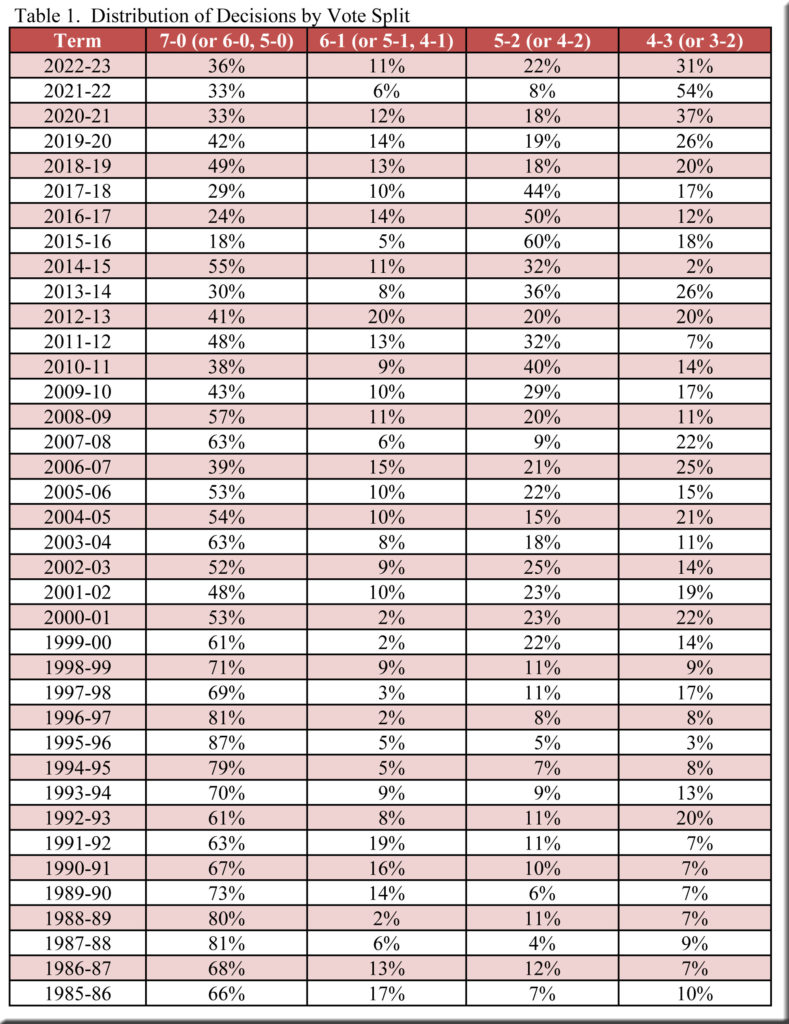Now that the court has filed its final substantive decision of the term, the time has arrived for our annual statistical examination of the justices’ activity. Interesting topics abound, including the surprising number of decisions, the issue of polarization, the role of Justice Hagedorn, and a mounting liberal voice—all of which we’ll consider today, before moving on to other matters in a week or two.
Number of decisions filed
The court’s output of 45 decisions this term was strikingly low—only once, in 2015-16, have the justices decided fewer cases, as shown in Graphs 1 and 2.[1] Last year’s total of 52 decisions, following a yield of 51 in 2020-21, made it possible to hypothesize that the justices were seeking an annual average in the low 50s. But this year’s set of 45 decisions raises the question of whether the justices have a particular target in mind—and if so, can they approach it? In any event, it’s more difficult now than it seemed a year ago to venture a prediction for the upcoming term.
Polarization
Last year we observed that “a court becomes polarized when an unyielding bloc of justices almost always votes together, and almost always in opposition to another, similarly resolute set of justices.” Two such blocs were apparent in 2021-22—a liberal trio (Justices A.W. Bradley, Dallet, and Karofsky) who voted in unison 88% of the time and three conservatives (Justices Roggensack, Ziegler, and R.G. Bradley) who sided together in 92% of their votes. In 2022-23 this unity weakened among the liberal contingent (dropping from 88% to 80%), and for the three conservatives it eroded a good deal more, from 92% to 72%.[2] Thus, if bloc cohesion serves as a measure of polarization, the court may have been somewhat less polarized in 2022-23 than in the previous term.
Be that as it may, the preceding figures suggest that this year’s court was not likely to match the extraordinary proportion of 4-3 decisions filed by the justices in 2021-22—54% of all cases, a far larger share than in any other year covered by SCOWstats. The rigid voting “discipline” noted in the foregoing paragraph accounted for most of these 4-3 outcomes in 2021-22, and, with the waning of this bloc cohesion in 2022-23, one could expect fewer 4-3 decisions (or at least a greater variety of 4-3 majorities). As it turned out, 5-2 decisions recorded the biggest gain in 2022-23, while 4-3 results fell to 31% of all cases (Table 1)—still at a level exceeding all except the two previous terms, but also a substantial decline from the peak of 54% in 2021-22.[3]
Justice Hagedorn
Just as noteworthy as the shrinking percentage of 4-3 decisions is the altered role of Justice Hagedorn in these cases. Last term he was nearly indispensable, voting in the majority of 4-3 decisions 86% of the time—much more often than any other justice. By 2022-23 he was still appearing regularly in the majorities of the court’s 4-3 decisions, but no more so now than Justices AW Bradley and Dallet—and less habitually than Justice Karofsky (Table 2).
This implies that Justice Hagedorn sided more often with the liberals in 4-3 decisions during 2022-23 than in the preceding term, as indeed he did. Last year we found him dividing his votes evenly between the liberal and conservative blocs—tipping the balance to the liberals 12 times and to the conservatives 12 time in the 24 cases where he formed part of a 4-3 majority in 2021-22. That changed in 2022-23, as Justice Hagedorn joined the three liberals in fully 70% of his 10 majority votes cast in 4-3 cases.[4]
A Rising Liberal Tide
Broadening the focus beyond Justice Hagedorn, one is struck by the increasing prevalence of the court’s three liberals in 4-3 majorities over the past three terms, and the corresponding slippage among the conservatives—vividly evident in Table 2.[5]
This is a remarkable transformation in just three years, without any change in the court’s membership. It would appear to indicate that the liberals have become more adept or more interested than the conservatives in consensus building—and that Justice Hagedorn is amenable. If so, and if this continues after the replacement of Justice Roggensack by Justice Protasiewicz (a presumed liberal), we might anticipate a further rise in the percentage of 5-2 decisions at the expense of 4-3 outcomes. A year hence, we’ll return for a look.
[1] Occasional deadlocked (3-3) per curiam decisions (including Neil J. Rennick v. Teleflex Medical Incorporated in 2022-23) are not included in these graphs. Nor are orders pertaining to various motions and petitions. The figure of 45 decisions for 2022-23 also excludes two cases dismissed as improvidently granted (Robert L. Slamka v. General Heating and Air Conditioning and State v. Daimon Von Jackson, Jr.). In Pepsi-Cola Metropolitan Bottling Company, Inc. v. Employers Insurance Company of Wausau, Justice Ziegler did not participate, and Justice Hagedorn withdrew from participation. No trio of the remaining justices could agree on a ruling, and thus I have omitted this case as well.
[2] The percentages are calculated for cases in which all three justices participated.
[3] Table 1 indicates that 5-2 (or 4-2) decisions increased from 8% of all decisions in 2021-22 to 22% in 2022-23. There were 10 such decisions this term, and Justice Hagedorn voted with the majority in every one of them. Justice Karofsky joined the majority in all but one, followed by Justices Dallet and Roggensack (7 majority votes each), Justices Ziegler and RG Bradley (6 majority votes each), and Justice AW Bradley (4 majority votes).
[4] Justice Hagedorn dissented four times in 4-3 decisions, joining Justices Ziegler and RG Bradley twice, Justices AW Bradley and Dallet once, and Justices Roggensack and Ziegler once.
[5] Click here for a comparable table covering all cases (unanimous and nonunanimous decisions). The progression through the years is not as consistent as in the table for 4-3 decisions, but by 2022-23 all three liberal justices were voting in the majority more frequently than Justices Roggensack, Ziegler, or RG Bradley.




[…] than any of their colleagues. Professor Alan Ball of Marquette University made similar findings in his review of the 2022-23 term, published in the SCOWstats […]